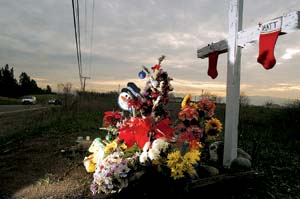They are symbols of lives lost and a way for family and friends
to remember their loved ones. But some say roadside memorials have
no place on public roads because they are a safety hazard that can
cause more similar accidents.
Hollister – They are symbols of lives lost and a way for family and friends to remember their loved ones. But some say roadside memorials have no place on public roads because they are a safety hazard that can cause more similar accidents.
For as long as Peter Sonne has lived here, memorials have been a part of the landscape, dotting rural roads with their crosses, flowers and names of the dead. Some are simple white crosses, while others are more elaborate memorials complete with flowers, candles and messages from friends.
“They are just something people feel they need to do,” said Sonne, who is president of Hollister’s Historical Society and has lived in the area since the late ’50s.
When three Hollister teenagers perished in a car crash near San Felipe and Fairview roads in October, the spot instantly became a gathering place for friends and classmates to leave notes, teddy bears and candles. And they helped the mourners find an outlet for the pain they were feeling.
“Young people really tend to gravitate to these memorials because they help them cope with the tragedy and bring a sense of closure,” said Father Rudy Ruiz, of Sacred Heart/St. Benedict’s Church, who blessed the site for the fallen teens days after the accident.
For Catholics, the place of death is where the soul leaves the body and is directed to heaven. “It’s the spot where they are born into eternity,” said Father Ruiz.
For others, the memorials are simply a way to remember their lost family and friends.
Days after the deaths of P.J. Galvan and Matthew Lopez at Santa Ana Valley and Fairview roads in December 2003, family and friends flocked to the site of the accident to leave flowers, messages and written prayers for the boys because it was the only place they had to feel close to their friends. The pair was killed while riding in a car with an intoxicated driver.
“We would stand there in the rain and laughing and crying as we shared stories about P.J.,” said Tyler Raisbeck, 20, who was a close friend of Galvan.
The memorial became more formalized when a man who lives near the site of the accident offered to build a cross on the spot, said Laura Lopez, Matthew’s mother. After the accident, the Lopez family used to go at least a couple of times to the memorial, but have since reduced their visits.
“From now, that will be the place where the kids will go to connect to their friends.”
On the anniversary of the boys’ deaths, Dec. 6, the Lopez and Galvan families returned to the memorial with a Christmas tree, which the boys’ friends decorated with ornaments bearing special messages.
And while some memorials serve a modern purpose for the living, others seem like historical reminders of senseless tragedies left behind by time. Such as the five crosses near the Highway 25 and Bolsa Road intersection, where seven people died, including a family of five, in the early morning hours of Feb. 19, 2000. The Gilroy family was hit head-on by two men in a small truck who were driving on the wrong side of the road. The names of the crosses have been bleached out by sun and grass grows high around the aging memorial.
While the California Department of Transportation has a strict policy about the memorials and will usually take them down several days after they are put up, the county is more lax and usually turns a blind eye unless they obstruct traffic.
“You’ve got cars parked on either side and people crossing the street to visit them,” said Arman Nazemi, assistant director of the department. “It can create a dangerous situation.”
Technically, the department of public works requires encroachment permits from families who want to set up anything on county roads, but as of yet, the agency has not received a single request.
Several law suits have been filed around the U.S., claiming the memorials on public space are a constitutional breech because they display religious symbols. Others have said that there are plenty of other spaces for family and friends to grieve such as the cemetery, church or in their own homes.
“There is are places for people to express themselves and public highways aren’t one of them,” said Robert Boston, spokesperson for Americans United for Separation of Church and State.
But Laura Lopez, disagrees. She sees the memorial as an important, if solemn, reminder of her son’s short life and a warning to other kids to slow down and, above all, never drink and drive.
“If it can save one life, the memorial will be worth it,” she said.
Karina Ioffee covers education for the Free Lance. Reach her at (831)637-5566 ext. 335 or ki*****@***********ws.com










